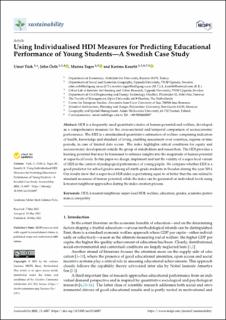| dc.contributor.author | Turk, Umut | |
| dc.contributor.author | Östh, John | |
| dc.contributor.author | Toger, Marina | |
| dc.contributor.author | Kourtit, Karima | |
| dc.date.accessioned | 2023-01-26T15:29:10Z | |
| dc.date.available | 2023-01-26T15:29:10Z | |
| dc.date.created | 2022-02-03T12:12:41Z | |
| dc.date.issued | 2021-05-28 | |
| dc.identifier.citation | Sustainability. 2021, 13 (11), . | en_US |
| dc.identifier.issn | 2071-1050 | |
| dc.identifier.uri | https://hdl.handle.net/11250/3046680 | |
| dc.description.abstract | HDI is a frequently used quantitative index of human potential and welfare, developed as a comprehensive measure for the cross-sectional and temporal comparison of socioeconomic performance. The HDI is a standardised quantitative estimation of welfare comprising indicators of health, knowledge and standard of living, enabling assessment over countries, regions or time periods, in case of limited data access. The index highlights critical conditions for equity and socioeconomic development outside the group of stakeholders and researchers. The HDI provides a learning potential that may be harnessed to enhance insights into the magnitude of human potential at super-local levels. In this paper we design, implement and test the validity of a super-local variant of HDI in the context of pedagogical performance of young pupils. We compare whether HDI is a good predictor for school grades among all ninth-grade students in Sweden during the year 2014. Our results show that a super-local HDI index is performing equal to or better than the one related to standard measures of human potential, while the index can be generated on individual levels using k-nearest neighbour approaches during the index creation process. | en_US |
| dc.language.iso | eng | en_US |
| dc.publisher | MDPI | en_US |
| dc.relation.ispartofseries | Sustainability;Volume 13 / Issue 11 | |
| dc.rights | Navngivelse 4.0 Internasjonal | * |
| dc.rights.uri | http://creativecommons.org/licenses/by/4.0/deed.no | * |
| dc.subject | HDI | en_US |
| dc.subject | K-nearest neighbour | en_US |
| dc.subject | Super-local HDI | en_US |
| dc.subject | Welfare | en_US |
| dc.subject | Education | en_US |
| dc.subject | Academic performances | en_US |
| dc.title | Using Individualised HDI Measures for Predicting Educational Performance of Young Students—A Swedish Case Study | en_US |
| dc.type | Peer reviewed | en_US |
| dc.type | Journal article | en_US |
| dc.description.version | publishedVersion | en_US |
| dc.rights.holder | © 2021 by the authors | en_US |
| dc.source.articlenumber | 6087 | en_US |
| cristin.ispublished | true | |
| cristin.fulltext | original | |
| cristin.qualitycode | 1 | |
| dc.identifier.doi | https://doi.org/10.3390/su13116087 | |
| dc.identifier.cristin | 1997348 | |
| dc.source.journal | Sustainability | en_US |
| dc.source.volume | 13 | en_US |
| dc.source.issue | 11 | en_US |
| dc.source.pagenumber | 1-13 | en_US |

